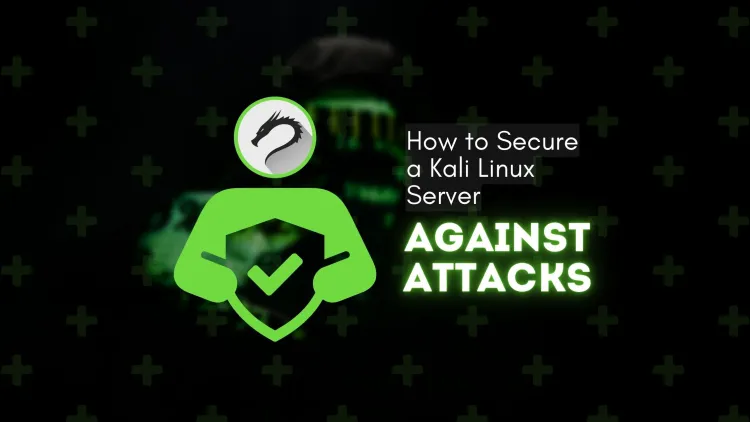How to Secure a Kali Linux Server Again st Attacks | The Complete Guide
Securing a Kali Linux server is critical to preventing unauthorized access and ensuring the safety of sensitive data. Essential security measures include regular system updates, configuring a strong firewall, disabling unnecessary services, using SSH key-based authentication, enabling two-factor authentication, monitoring logs, implementing SELinux or AppArmor, securing user accounts, encrypting data, and performing regular backups. Following these steps will significantly reduce the risk of attacks and help maintain the integrity of your Kali Linux server.

Kali Linux is a powerful platform used by cybersecurity professionals and ethical hackers to perform penetration testing, security auditing, and vulnerability assessments. However, like any system, a Kali Linux server can be vulnerable to attacks if not properly secured. Securing a Kali Linux server is critical to maintaining its integrity, protecting sensitive information, and ensuring it cannot be exploited by attackers.
In this blog, we'll walk through essential steps for securing a Kali Linux server and minimizing the risk of cyberattacks.
Why Is Securing a Kali Linux Server Important?
As Kali Linux is frequently used for penetration testing and ethical hacking, it's often a target for attackers. Without proper security measures, attackers can exploit vulnerabilities in the server to gain unauthorized access, compromise sensitive data, or use the server to launch further attacks. Securing your Kali Linux server ensures that your testing environment is safe, your data is protected, and your system remains trustworthy.
Steps to Secure a Kali Linux Server
1. Update and Patch the System Regularly
Keeping your Kali Linux server up to date is one of the most effective ways to secure it. Updates often include security patches that fix vulnerabilities that could be exploited by attackers. To update your system, use the following commands:
Regularly check for updates to ensure your system is patched and secure.
2. Configure a Strong Firewall
A firewall is essential for controlling network traffic to and from your server. Kali Linux uses iptables by default, but you can also use more user-friendly tools like ufw (Uncomplicated Firewall) to configure the firewall. A basic firewall setup can be done with:
This configuration allows SSH traffic while blocking other unwanted connections. Always tailor firewall rules to match your server's specific needs.
3. Disable Unnecessary Services
Kali Linux comes with a range of tools and services that may not be necessary for your specific use case. Each service running on your server can potentially be exploited by an attacker. To minimize the attack surface, disable unnecessary services:
For example, if you don’t need a web server, disable Apache:
4. Use SSH Key-Based Authentication for Remote Access
Using SSH with password authentication is risky, as attackers can brute-force passwords to gain unauthorized access. Instead, configure SSH key-based authentication, which is much more secure. To set up SSH keys:
- Generate an SSH key pair on your local machine:
- Copy the public key to your server:
- Disable password authentication by editing the
/etc/ssh/sshd_configfile: Restart the SSH service:
5. Enable Two-Factor Authentication (2FA)
Two-factor authentication (2FA) adds an extra layer of security when logging into your Kali Linux server. You can use tools like Google Authenticator or Authy to implement 2FA on your server. Install the required packages:
Follow the instructions to configure 2FA and add an extra layer of protection.
6. Monitor Logs and System Activity
Monitoring system logs is critical for detecting suspicious activity on your server. Tools like Fail2ban and Logwatch can help you keep track of failed login attempts, unusual access patterns, and other signs of an attack.
To install Fail2ban:
Configure Fail2ban to block IP addresses with repeated failed login attempts. It will help defend against brute-force attacks on your server.
7. Implement SELinux or AppArmor
Security-Enhanced Linux (SELinux) and AppArmor are security modules designed to provide additional access control. These tools restrict the actions that users and processes can perform, preventing unauthorized access to sensitive files or system resources. To enable SELinux, edit /etc/selinux/config and set:
Similarly, AppArmor can be installed and configured to enforce security policies for applications running on your server.
8. Secure User Accounts and Passwords
Creating strong user accounts and passwords is vital for securing your Kali Linux server. Avoid using weak or easily guessable passwords. Use tools like pwgen or openssl to generate strong passwords for your system.
Additionally, follow these guidelines:
- Remove unnecessary user accounts.
- Use the
sudocommand for administrative privileges. - Set up account lockouts after multiple failed login attempts.
9. Encrypt Sensitive Data
Encryption ensures that sensitive data stored on your Kali Linux server is protected even if the server is compromised. Use LUKS (Linux Unified Key Setup) to encrypt entire disks or partitions.
To encrypt a partition, use:
You can also encrypt specific directories or files with GPG or OpenSSL.
10. Regular Backups
Regular backups ensure that you have a safe copy of your system in case of an attack or a system failure. Automate backups using tools like rsync or Deja Dup, and store the backups in a secure location.
Conclusion
Securing a Kali Linux server requires implementing multiple layers of defense. Regular updates, strong access controls, firewalls, and monitoring tools are essential steps in hardening your server. By disabling unnecessary services, using SSH key-based authentication, enabling 2FA, and encrypting sensitive data, you can significantly reduce the risk of attacks. Always follow best security practices to ensure that your Kali Linux server remains protected and is able to fulfill its role in cybersecurity tasks without compromise.














![Top 10 Ethical Hackers in the World [2025]](https://www.webasha.com/blog/uploads/images/202408/image_100x75_66c2f983c207b.webp)








